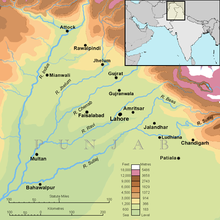Gakhars
| Gakhars | |
|---|---|
| Jāti | Rajput |
| Religions | |
| Languages | Punjabi |
| Country | |
| Region | Punjab |
| Ethnicity | Punjabi |
The Gakhar (Punjabi: گاکھر, romanized: Gakkhaŕ) is a historical Punjabi Muslim[1][2] tribe with origins in the northern Punjab, Pakistan.[3] The Gakhars now predominantly follow Islam after conversion from Hinduism during the Islamic rule in Punjab.[4][5][6]
History
In the Muslim historiography, the Gakhars have been frequently confused with the Khokhars, who inhabited the same region, and it has been challenging to separate the events of both tribes. Gakhars formed an important part of the army of Shāhis of Gandhāra. Around 30,000 Gakhars fought against Maḥmūd of Ghazna in 1008 CE near Peshawar but were defeated.[2] By the time of Sultan Muʿizz al-Dīn Muḥammad Ghūrī Gakhars had converted to Islam.[2]
In the following centuries, Gakhars engaged in a long-running struggle for sovereignty over the Salt Range with the neighbouring tribes:[7]
The history of this region (the Salt Range) from the thirteenth century onward had been a sickening record of wars between various dominant landowning and ruling clans of Punjabi Muslims including the Janjuas, Gakhars, Thathals and Bhattis for political ascendancy.[8]
For a period, Gakhars were superseded by the Khokhars who under their chieftain Jasrat gained control of most of upper Punjab in the 15th century. However, by the time of Mughal emperor Bābur's invasion of subcontinent, Gakhars had regained power. Under their chief Hātī Khān, Gakhars attacked Babūr in 1525 when he marched against the Delhi Sultanate. Babūr siezed Gakhar fortress of Phaŕwāla and Hātī Khān fled, but when Hātī Khān offerred his submission to Babūr and provided supplies for the Mughal army, he compensated Hātī Khān well and conferred on him the title of Sultan.[2]

During the reign of Humāyūn, Sulṭān Sārang Khān gained much prominence. He refused to acknowledge Shēr Shāh Sūr as new emperor when the latter defeated Humāyūn, as a result Shēr Shāh led an expedition against Sārang Khān who was defeated and executed. His tomb is in Rawāt.[2]
Sārang Khān's brother, Ādam Khān succeeded him. In 1552, Humāyūn's rebel brother prince Kamrān sought shelter with Ādam Khān but he was betrayed and given up to Humāyūn, who rewarded Ādam Khān with the insignia of nobility for the treachery.[2]
In 1555, Ādam Khān was defeated and killed by his nephew Kamāl Khān, a son of Sārang Khān, possibly on the instigation by emperor Akbar to strengthen his hold over the Gakhars. Further a daughter of Kamāl Khān's brother, Sayd Khān was married to prince Salim.[2]
18th century

In the early 18th century, Gakhars gained independence from Mughals. They controlled major regions of Potohar between Jhelum and Indus, including Rawalpindi, Pharwala, Gujar Khan, Kahuta, Fatehjang and Rohtas.[9] The notable Gakhar chief Muqarrab Khan conquered cities of Gujrat and Jhelum in 1740.[10] He issued his own coins in which he claimed to be ruler of tract between Attock and Chenab.[10] He defeated the Yusafzai Afghans and Jang Kuli Khan of Khattak and overran as far north as Bhimber.[10] However, the Bhangi misl under Sardar Milka Singh forced him to give up control of Gujarat in 1765 and he returned to Jehlum.[10] In 1769 he was treacherously captured and put to death by a rival chief, Himmat Khan of Bugial clan. Ultimately Sikhs conquered Rawalpindi too in 1767 and Gakhars were left with only Phurwala and Jhelum under their control.[10] Muqarrab's son succeeded to his dominions, until Jhelum (1810) and Pharwala (1818) fell to the Ranjit Singh's invasions.[10]
See also
- Sarang Gakhar, Chief of Gakhars
- List of Punjabi tribes
- Gakhar Mandi
References
- ^ Bakshi 1995, p. 142.
- ^ a b c d e f g Ansari 2012.
- ^ Van Donzel, E. J., ed. (1994). Islamic Desk Reference. BRILL. p. 106. ISBN 978-9-00409-738-4.
- ^ Gandhi, Surjit Singh (2007). History of Sikh Gurus Retold: 1469-1606 C.E. Atlantic Publishers. p. 3. ISBN 978-81-269-0857-8.
The story of most of the Gakhars is that they conquered Kashmir and ruled in that region for many generations but were eventually driven back to Kabul whence they entered the Punjab. They professed the Hindu faith and were converted to Islam, probably after the Ghori rule.
- ^ Singha, Atara (1976). Socio-cultural Impact of Islam on India. Panjab University. p. 46.
After this period, we do not hear of any Hindu Gakhars or Khokhars, for during the next two or three centuries they had all come to accept Islam.
- ^ Chandra, Satish (2006). Medieval India: From Sultanat to the Mughals. Vol. 2 (Revised, 2nd ed.). Har-Anand Publications. p. 45. ISBN 978-8-12411-066-9.
- ^ Journal of the Pakistan Historical Society, Volume 54, Issues 1–2. Pakistan Historical Society. 2006.
- ^ Bakshi, S. R. (1995). Advanced History of Medieval India. Anmol Publications. p. 142. ISBN 978-8-17488-028-4.
- ^ Punjab District Gazetteers: Rawalpindi District (v. 28-A). Haideri Press. 1909.
- ^ a b c d e f Gazetteer of the Rawalpindi district. "Civil and Military Gazette" Press. 1895.
Bibliography
- Ansari, A.S. Bazmee (2012). "Gakkhaŕ". The Encyclopaedia of Islam, Second Edition (12 vols.). Leiden: E. J. Brill.
Further reading
- Khan, Chaudhary Muhammad Afzal (1357 H). Rajpūt Gotaīñ (in Urdu) – via Rekhta.org.
{{cite book}}: CS1 maint: numeric names: authors list (link)
- Articles with short description
- Short description is different from Wikidata
- Wikipedia semi-protected pages
- Use dmy dates from March 2022
- Use Pakistani English from March 2011
- All Wikipedia articles written in Pakistani English
- Articles containing Punjabi-language text
- CS1 maint: numeric names: authors list
- CS1 Urdu-language sources (ur)
- Articles with J9U identifiers
- Articles with LCCN identifiers
- Punjabi people
- Punjabi tribes
- Social groups of Punjab, Pakistan